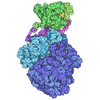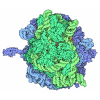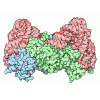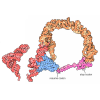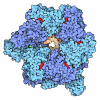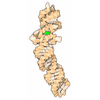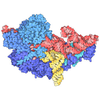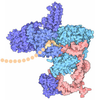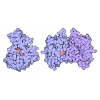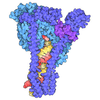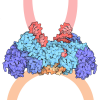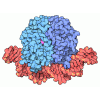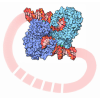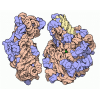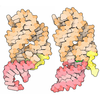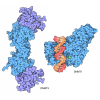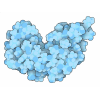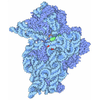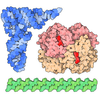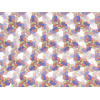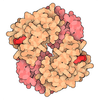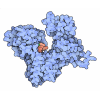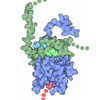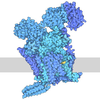[English] 日本語
 Yorodumi
Yorodumi- PDB-8gan: Exploiting Activation and Inactivation Mechanisms in Type I-C CRI... -
+ Open data
Open data
- Basic information
Basic information
| Entry | Database: PDB / ID: 8gan | ||||||
|---|---|---|---|---|---|---|---|
| Title | Exploiting Activation and Inactivation Mechanisms in Type I-C CRISPR-Cas3 for Genome Editing Applications | ||||||
 Components Components |
| ||||||
 Keywords Keywords | HYDROLASE/RNA/DNA / CRISPR / type I-C / cascade / anti-CRISPR / HYDROLASE-RNA-DNA complex | ||||||
| Function / homology |  Function and homology information Function and homology informationmaintenance of CRISPR repeat elements / endonuclease activity / defense response to virus / Hydrolases; Acting on ester bonds / hydrolase activity / RNA binding Similarity search - Function | ||||||
| Biological species |  Neisseria lactamica (bacteria) Neisseria lactamica (bacteria) | ||||||
| Method | ELECTRON MICROSCOPY / single particle reconstruction / cryo EM / Resolution: 3.26 Å | ||||||
 Authors Authors | Hu, C. / Nam, K.H. / Ke, A. | ||||||
| Funding support |  United States, 1items United States, 1items
| ||||||
 Citation Citation |  Journal: Mol Cell / Year: 2024 Journal: Mol Cell / Year: 2024Title: Exploiting activation and inactivation mechanisms in type I-C CRISPR-Cas3 for genome-editing applications. Authors: Chunyi Hu / Mason T Myers / Xufei Zhou / Zhonggang Hou / Macy L Lozen / Ki Hyun Nam / Yan Zhang / Ailong Ke /    Abstract: Type I CRISPR-Cas systems utilize the RNA-guided Cascade complex to identify matching DNA targets and the nuclease-helicase Cas3 to degrade them. Among the seven subtypes, type I-C is compact in size ...Type I CRISPR-Cas systems utilize the RNA-guided Cascade complex to identify matching DNA targets and the nuclease-helicase Cas3 to degrade them. Among the seven subtypes, type I-C is compact in size and highly active in creating large-sized genome deletions in human cells. Here, we use four cryoelectron microscopy snapshots to define its RNA-guided DNA binding and cleavage mechanisms in high resolution. The non-target DNA strand (NTS) is accommodated by I-C Cascade in a continuous binding groove along the juxtaposed Cas11 subunits. Binding of Cas3 further traps a flexible bulge in NTS, enabling NTS nicking. We identified two anti-CRISPR proteins AcrIC8 and AcrIC9 that strongly inhibit Neisseria lactamica I-C function. Structural analysis showed that AcrIC8 inhibits PAM recognition through allosteric inhibition, whereas AcrIC9 achieves so through direct competition. Both Acrs potently inhibit I-C-mediated genome editing and transcriptional modulation in human cells, providing the first off-switches for type I CRISPR eukaryotic genome engineering. | ||||||
| History |
|
- Structure visualization
Structure visualization
| Structure viewer | Molecule:  Molmil Molmil Jmol/JSmol Jmol/JSmol |
|---|
- Downloads & links
Downloads & links
- Download
Download
| PDBx/mmCIF format |  8gan.cif.gz 8gan.cif.gz | 604 KB | Display |  PDBx/mmCIF format PDBx/mmCIF format |
|---|---|---|---|---|
| PDB format |  pdb8gan.ent.gz pdb8gan.ent.gz | 493.6 KB | Display |  PDB format PDB format |
| PDBx/mmJSON format |  8gan.json.gz 8gan.json.gz | Tree view |  PDBx/mmJSON format PDBx/mmJSON format | |
| Others |  Other downloads Other downloads |
-Validation report
| Summary document |  8gan_validation.pdf.gz 8gan_validation.pdf.gz | 930.6 KB | Display |  wwPDB validaton report wwPDB validaton report |
|---|---|---|---|---|
| Full document |  8gan_full_validation.pdf.gz 8gan_full_validation.pdf.gz | 1006.4 KB | Display | |
| Data in XML |  8gan_validation.xml.gz 8gan_validation.xml.gz | 96.7 KB | Display | |
| Data in CIF |  8gan_validation.cif.gz 8gan_validation.cif.gz | 145.6 KB | Display | |
| Arichive directory |  https://data.pdbj.org/pub/pdb/validation_reports/ga/8gan https://data.pdbj.org/pub/pdb/validation_reports/ga/8gan ftp://data.pdbj.org/pub/pdb/validation_reports/ga/8gan ftp://data.pdbj.org/pub/pdb/validation_reports/ga/8gan | HTTPS FTP |
-Related structure data
| Related structure data |  29901MC  8g9sC  8g9tC  8g9uC  8gafC  8gamC M: map data used to model this data C: citing same article ( |
|---|---|
| Similar structure data | Similarity search - Function & homology  F&H Search F&H Search |
- Links
Links
- Assembly
Assembly
| Deposited unit | 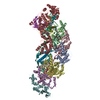
|
|---|---|
| 1 |
|
- Components
Components
-Protein , 4 types, 12 molecules ABCDEFMGIJHN
| #1: Protein | Mass: 32208.111 Da / Num. of mol.: 7 Source method: isolated from a genetically manipulated source Source: (gene. exp.)  Neisseria lactamica (bacteria) / Gene: NCTC10618_01084 / Production host: Neisseria lactamica (bacteria) / Gene: NCTC10618_01084 / Production host:  #2: Protein | Mass: 14245.184 Da / Num. of mol.: 3 Source method: isolated from a genetically manipulated source Source: (gene. exp.)  Neisseria lactamica (bacteria) / Gene: NCTC10618_01085 / Production host: Neisseria lactamica (bacteria) / Gene: NCTC10618_01085 / Production host:  #3: Protein | | Mass: 64718.613 Da / Num. of mol.: 1 Source method: isolated from a genetically manipulated source Source: (gene. exp.)  Neisseria lactamica (bacteria) / Gene: NCTC10618_01085 / Production host: Neisseria lactamica (bacteria) / Gene: NCTC10618_01085 / Production host:  #6: Protein | | Mass: 23870.451 Da / Num. of mol.: 1 Source method: isolated from a genetically manipulated source Source: (gene. exp.)  Neisseria lactamica (bacteria) / Gene: cas5d / Production host: Neisseria lactamica (bacteria) / Gene: cas5d / Production host:  |
|---|
-RNA chain , 1 types, 1 molecules K
| #4: RNA chain | Mass: 13816.202 Da / Num. of mol.: 1 / Source method: obtained synthetically / Source: (synth.)  Neisseria lactamica (bacteria) Neisseria lactamica (bacteria) |
|---|
-DNA chain , 3 types, 3 molecules LOQ
| #5: DNA chain | Mass: 16410.494 Da / Num. of mol.: 1 / Source method: obtained synthetically / Source: (synth.)  Neisseria lactamica (bacteria) Neisseria lactamica (bacteria) |
|---|---|
| #7: DNA chain | Mass: 5846.880 Da / Num. of mol.: 1 / Source method: obtained synthetically / Source: (synth.)  Neisseria lactamica (bacteria) Neisseria lactamica (bacteria) |
| #8: DNA chain | Mass: 6424.217 Da / Num. of mol.: 1 / Source method: obtained synthetically / Source: (synth.)  Neisseria lactamica (bacteria) Neisseria lactamica (bacteria) |
-Experimental details
-Experiment
| Experiment | Method: ELECTRON MICROSCOPY |
|---|---|
| EM experiment | Aggregation state: PARTICLE / 3D reconstruction method: single particle reconstruction |
- Sample preparation
Sample preparation
| Component | Name: type I-C Cascade at R-loop formation / Type: COMPLEX / Entity ID: all / Source: MULTIPLE SOURCES |
|---|---|
| Molecular weight | Value: 0.4 MDa / Experimental value: YES |
| Source (natural) | Organism:  Neisseria lactamica (bacteria) Neisseria lactamica (bacteria) |
| Source (recombinant) | Organism:  |
| Buffer solution | pH: 7.5 / Details: 25mM Tris pH 7.5, 150mM NaCl |
| Buffer component | Conc.: 150 mM / Name: sodium chloride / Formula: NaCl |
| Specimen | Conc.: 1 mg/ml / Embedding applied: NO / Shadowing applied: NO / Staining applied: NO / Vitrification applied: YES |
| Specimen support | Grid material: COPPER / Grid mesh size: 400 divisions/in. / Grid type: Quantifoil R1.2/1.3 |
| Vitrification | Instrument: FEI VITROBOT MARK IV / Cryogen name: ETHANE / Humidity: 100 % / Chamber temperature: 278 K |
- Electron microscopy imaging
Electron microscopy imaging
| Experimental equipment |  Model: Talos Arctica / Image courtesy: FEI Company |
|---|---|
| Microscopy | Model: FEI TALOS ARCTICA |
| Electron gun | Electron source:  FIELD EMISSION GUN / Accelerating voltage: 200 kV / Illumination mode: FLOOD BEAM FIELD EMISSION GUN / Accelerating voltage: 200 kV / Illumination mode: FLOOD BEAM |
| Electron lens | Mode: DIFFRACTION / Nominal magnification: 67000 X / Nominal defocus max: 3500 nm / Nominal defocus min: 2500 nm / Calibrated defocus min: 1500 nm / Calibrated defocus max: 3000 nm / Cs: 2.7 mm / C2 aperture diameter: 100 µm / Alignment procedure: COMA FREE |
| Specimen holder | Cryogen: NITROGEN / Specimen holder model: FEI TITAN KRIOS AUTOGRID HOLDER / Temperature (max): 100 K / Temperature (min): 70 K |
| Image recording | Average exposure time: 2.5 sec. / Electron dose: 50 e/Å2 / Film or detector model: GATAN K3 (6k x 4k) / Num. of grids imaged: 1798 / Num. of real images: 1798 |
| EM imaging optics | Energyfilter name: GIF Bioquantum |
- Processing
Processing
| EM software |
| ||||||||||||||||
|---|---|---|---|---|---|---|---|---|---|---|---|---|---|---|---|---|---|
| CTF correction | Type: PHASE FLIPPING AND AMPLITUDE CORRECTION | ||||||||||||||||
| 3D reconstruction | Resolution: 3.26 Å / Resolution method: FSC 0.143 CUT-OFF / Num. of particles: 108723 / Num. of class averages: 6 / Symmetry type: POINT | ||||||||||||||||
| Atomic model building | Protocol: RIGID BODY FIT |
 Movie
Movie Controller
Controller







 PDBj
PDBj
